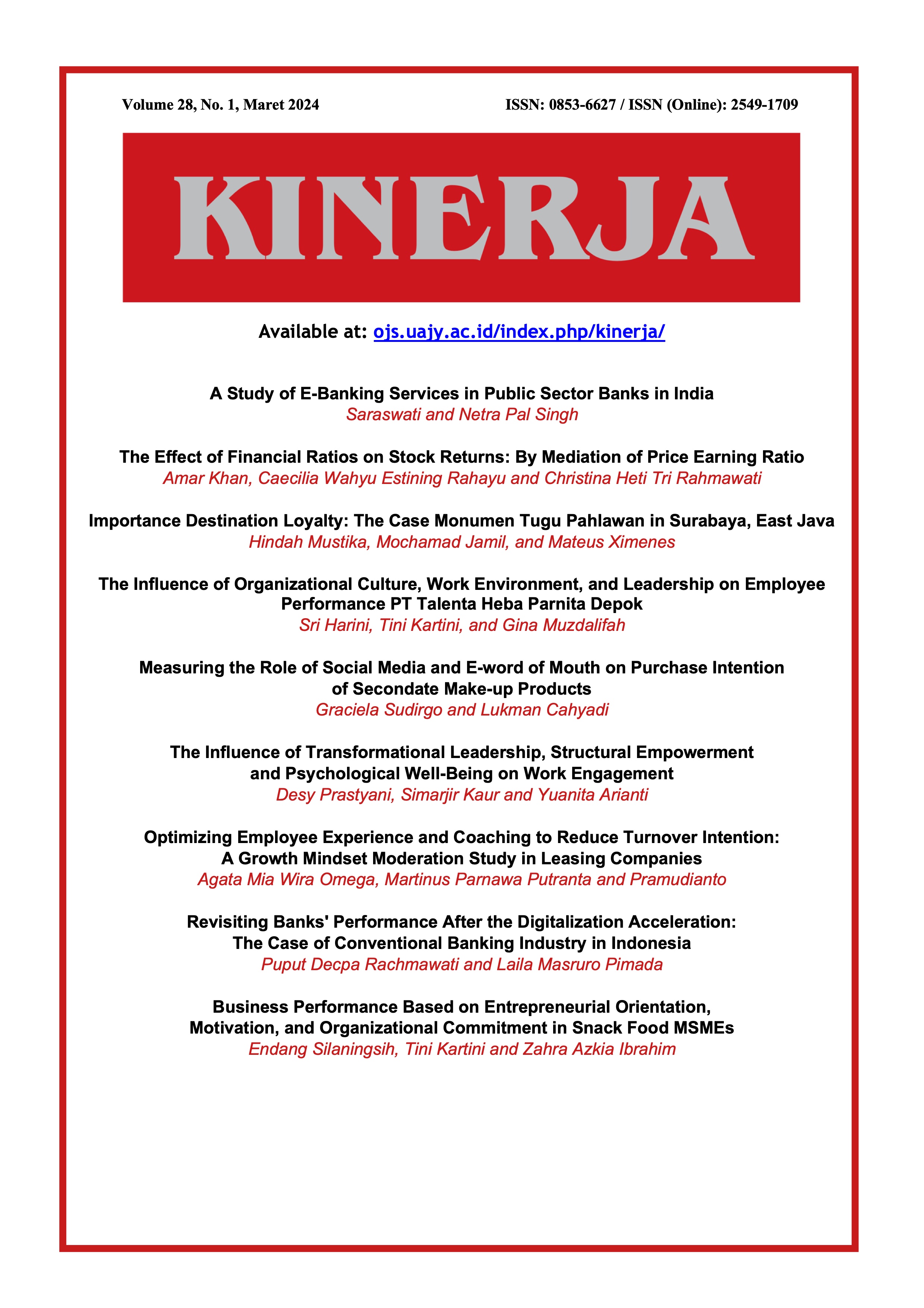Importance Destination Loyalty: The Case Monumen Tugu Pahlawan in Surabaya, East Java
DOI:
https://doi.org/10.24002/kinerja.v28i1.8101Keywords:
destination, satisfaction, patriotism, genderAbstract
The focus of the research is to examine and analyze the factors of the importance of destination loyalty in historical places. It can be said that historical places have their uniqueness or characteristics as an identity and value that must be preserved. Method: This research uses a quantitative method where SEM-PLS is used to test and analyze the collected data in the form of respondents' answers in the questionnaire. The number of respondents was 210, who had characteristics of educational background, age, gender, and social media used so that this could describe the level of respondents' understanding of knowledge and love of historical places. Results showed that the three antecedents are tourist satisfaction, patriotism, and gender, which motivate someone to intend and re-visit a monument and influence destination loyalty. It can be clearly illustrated that respondents have a strong emotional bond with the historical value of destination loyalty. Novelty: gender has an important meaning and can be a moderating variable. Originality: historical value in the form of the results of the struggle of Surabaya youth against the colonialists, which is then realized in a destination.
References
Al‐Msallam, S., 2020. The impact of tourists’ emotions on satisfaction and destination loyalty – an integrative moderated mediation model: Tourists’ experience in Switzerland. Journal of Hospitality and Tourism Insights, 3(5), pp.509–528.
Albaity, M., and Melhem, S. B., 2017. Novelty seeking, image, and loyalty—The mediating role of satisfaction and moderating role of length of stay: International tourists’ perspective. Tourism Management Perspectives, 23, pp.30–37.
Almeida-Santana, A., and Moreno-Gil, S., 2017. New trends in information search and their influence on destination loyalty: Digital destinations and relationship marketing. Journal of Destination Marketing and Management, 6(2), pp.150–161.
Almeida-Santana, A., and Moreno-Gil, S., 2018. Understanding tourism loyalty: Horizontal vs. destination loyalty. Tourism Management, 65, pp. 245–255.
Alonso Dos Santos, M., Velasco Vizcaíno, F., and Pérez Campos, C., 2020. The influence of patriotism and fans’ fulfilment of sponsorship activation in the sponsor’s image transfer process. Sport in Society, 23(2), pp.280–295.
Alshira’h, A. F., Al-Shatnawi, H. M., Al-Okaily, M., Lutfi, A., and Alshirah, M. H., 2021. Do public governance and patriotism matter? Sales tax compliance among small and medium enterprises in developing countries: Jordanian evidence. EuroMed Journal of Business, 16(4), pp.431–455.
Amornwitthawat, P., and Phongkhieo, N. T., 2019. Pro-environmental behaviours of visitors to Thailand’s national parks and factors discriminating the behaviours. Asia Pacific Journal of Tourism Research, 24(10), pp.993-1004.
Arieza, U., 2023. 8 Tempat Bersejarah di Surabaya yang Bisa Dikunjungi Saat 17 Agustus. Kompas.com. Available at: https://travel.kompas.com/read/2023/07/31/204000527/8-tempat-bersejarah-di-surabaya-yang-bisa-dikunjungi-saat-17-agustus?page=all
Arlotta, A. I., 2020. Locating heritage value in building material reuse. Journal of Cultural Heritage Management and Sustainable Developmen, 10(1), pp. 6–15.
Avrami, E., 2016. Making historic preservation sustainable. Journal of the American Planning Association, 82(2), pp.104-112.
Bhat, S. A., and Darzi, M. A., 2018. Antecedents of tourist loyalty to tourist destinations: A mediated-moderation study. International Journal of Tourism Cities, 4(2), pp. 261–278.
Bianchi, C., Milberg, S., and Cúneo, A., 2017. Understanding travelers’ intentions to visit a short versus long-haul emerging vacation destination: The case of Chile. Tourism Management, 59, pp. 312–324.
Biswas, C., Deb, S. K., Hasan, A. A. T., and Khandakar, M. S. A., 2020. Mediating effect of tourists’ emotional involvement on the relationship between destination attributes and tourist satisfaction. Journal of Hospitality and Tourism Insights, 4(4), pp. 490–510.
Blanco-moreno, S., Gonz, A. M., and Muñoz-gallego, P. A., 2022. Big data in tourism marketing: Past research and future opportunities marketing. Spanish Journal of Marketing - ESIC.
Boon Liat, C., Nikhashemi, S. R., and Dent, M. M., 2020. The chain effects of service innovation components on the building blocks of tourism destination loyalty: The moderating role of religiosity. Journal of Islamic Marketing, 12(9), pp. 1887–1929.
Gabriel, J., Marta, B., and Raffaele, D. (2013. The behaviour of repeat visitors to museums: review and empirical findings. Quality & Quantity, 48, pp.2817-2840.
Castelló, E., and Mihelj, S., 2018. Selling and consuming the nation: Understanding consumer nationalism. Journal of Consumer Culture, 18(4), pp. 558–576.
Chang, K. C., 2013. How reputation creates loyalty in the restaurant sector. International Journal of Contemporary Hospitality Management, 25(4), pp.536-557.
Chen, C. F., and Phou, S., 2013. A closer look at destination: Image, personality, relationship and loyalty. Tourism Management, 36, pp. 269–278.
Chi, C. G. Q., Chua, B. L., Othman, M. and Karim, S. A., 2013. Investigating the structural relationships between food image, food satisfaction, culinary quality, and behavioral intentions: The case of Malaysia. International Journal of Hospitality & Tourism Administration, 14(2), pp.99-120.
Chiu, W., Zeng, S. and Cheng, P. S. T., 2016. The influence of destination image and tourist satisfaction on tourist loyalty: a case study of Chinese tourists in Korea. International Journal of Culture, Tourism and Hospitality Research, 10(2), pp.223-234.
Chou, S. W., 2020. Understanding relational virtual community members’ satisfaction from a social learning perspective. Journal of Knowledge Management, 24(6), pp.1425–1443.
Del Chiappa, G., Andreu, L., and Gallarza, M. G., 2014. Emotions and visitors’ satisfaction at a museum. International Journal of Culture, Tourism, and Hospitality Research, 8(4), pp.420–431.
Deng, Q. and Li, M., 2014. A model of event–destination image transfer. Journal of Travel Research, 53(1), pp.69-82.
Fredheim, L. H. and Khalaf, M., 2016. The significance of values: Heritage value typologies re-examined. International Journal of Heritage Studies, 22(6), pp.466-481.
Gangl, K., Torgler, B., and Kirchler, E., 2016. Patriotism’s impact on cooperation with the state: An experimental study on tax compliance. Political Psychology, 37(6), pp.867-881.
Gurova, O., 2019. Patriotism as creative (counter-) conduct of Russian fashion designers. Consumer Culture Theory, pp.151-168.
Hair, J., Hult, G., Ringle, C., and Sarstedt, M. 2014. A Primer on Partial Least Squares Structural Equation Modeling (PLS-SEM). Thousand Oaks: SAGE Publications Ltd.
Hasan, M. K., Abdullah, S. K., Lew, T. Y. and Islam, M. F., 2020. Determining factors of tourists’ loyalty to beach tourism destinations: A structural model. Asia Pacific Journal of Marketing and Logistics, 32(1), pp.169-187.
Hasan, K., Abdullah, S.K., Islam, F. and Neela, N.M., 2020. An integrated model for examining tourists’ revisit intention to beach tourism destinations. Journal of Quality Assurance in Hospitality & Tourism, 21(6), pp.716-737.
Hess, R., 2011. Playing with ‘patriotic fire’: Women and football in the antipodes during the great war. International Journal of The History of Sport, 28(10), pp.1388-1408.
Huang, S. and van der Veen, R., 2019. The moderation of gender and generation in the effects of perceived destination image on tourist attitude and visit intention: A study of potential Chinese visitors to Australia. Journal of Vacation Marketing, 25(3), pp.375-389.
Hultman, M., Skarmeas, D., Oghazi, P., and Beheshti, H. M., 2015. Achieving tourist loyalty through destination personality, satisfaction, and identification. Journal of Business Research, 68(11), pp.2227–2231.
Jalilvand, M. R., Pool, J. K., Vosta, L. N., and Nafchali, J. S., 2014. The effect of marketing constructs and tourists’ satisfaction on loyalty to a sport destination: A structural equation model and analysis. Education, Business and Society: Contemporary Middle Eastern Issues, 7(4), pp.316–332.
Jazulli. (2015). Peran Undian Barang Dalam Pembangunan Monumen Tugu Pahlawan Surabaya 1952. Avatara,e-Jurnal Pendikan Sejarah, 3(3),pp. 507–520.
Jeong, Y. and Kim, S., 2020. A study of event quality, destination image, perceived value, tourist satisfaction, and destination loyalty among sport tourists. Asia Pacific Journal of Marketing and Logistics, 32(4), pp.940-960.
Jeong, Y. and Kim, S., 2019. Exploring a suitable model of destination image: The case of a small-scale recurring sporting event. Asia Pacific Journal of Marketing and Logistics, 31(5), pp.1287-1307.
Kara, D., Uysal, M. and Magnini, V.P., 2012. Gender differences on job satisfaction of the five‐star hotel employees: The case of the Turkish hotel industry. International Journal of Contemporary Hospitality Management, 24(7), pp.1047-1065.
Karimi, S., Shakery, A. and Verma, R., 2021. Online news media website ranking using user-generated content. Journal of Information Science, 47(3), pp.340-358.
Kaur, A., Chauhan, A. and Medury, Y., 2016. Destination image of Indian tourism destinations: An evaluation using correspondence analysis. Asia Pacific Journal of Marketing and Logistics, 28(3), pp.499-524.
Kazumi, T. and Kawai, N., 2017. Institutional support and women’s entrepreneurial self-efficacy. Asia Pacific Journal of Innovation and Entrepreneurship, 11(3), pp.345-365.
Kim, Y., Yim, K., and Ko, Y. J., 2013. Consumer patriotism and response to patriotic advertising: Comparison of international vs. national sport events. International Journal of Sports Marketing and Sponsorship, 14(3), pp.74–96.
Klugman, M., 2016. Female spectators, agency, and the politics of pleasure: An historical case study from australian rules football. International Journal of the History of Sport, 33(17), pp.2086–2104.
Lai, P.H., Chuang, S.T., Zhang, M.C. and Nepal, S.K., 2020. The non-profit sharing economy from a social exchange theory perspective: A case from World Wide Opportunities on Organic Farms in Taiwan. Journal of Sustainable Tourism, 28(12), pp.1970-1987.
Leavy, Patricia. 2017. Research Design Quantitative, Qualitative, Mixed Methods, Arts-Based, and Community-Based Participatory Research Approaches. New York: The Guilford Press.
Liputan6, 2022. Gubernur Khofifah: PDRB Sektor Pariwisata Jatim 2022 Naik Signifikan. Liputan6.com. Available at: https://www.liputan6.com/surabaya/read/5150980/gubernur-khofifah-pdrb-sektor-pariwisata-jatim-2022-naik-signifikan
Meleddu, M., Paci, R. and Pulina, M., 2015. Repeated behaviour and destination loyalty. Tourism Management, 50, pp.159-171.
Mensah, J., 2022. Community perception of heritage values regarding a global monument in Ghana: Implications for sustainable heritage management. Journal of Humanities and Applied Social Sciences, 4(4), pp.357–375.
Mgxekwa, B. B., Scholtz, M., and Saayman, M., 2019. A typology of memorable experience at Nelson Mandela heritage sites. Journal of Heritage Tourism, 14(4), pp.325–339.
Mjelde, J.W., Kim, H., Kim, T.K. and Lee, C.K., 2017. Estimating willingness to pay for the development of a peace park using CVM: The case of the Korean demilitarized zone. Geopolitics, 22(1), pp.151-175.
Mohaidin, Z., Wei, K.T. and Murshid, M.A., 2017. Factors influencing the tourists’ intention to select sustainable tourism destination: a case study of Penang, Malaysia. International Journal of Tourism Cities, 3(4), pp.442-465.
Özel, Ç.H. and Kozak, N., 2017. An exploratory study of resident perceptions toward the tourism industry in Cappadocia: A Social Exchange Theory approach. Asia Pacific Journal of Tourism Research, 22(3), pp.284-300.
Papikyan, H., 2023. Femmes arméniennes et pédagogie froebélienne: entre patriotisme éducatif et professionnalisation des institutrices préscolaires. Paedagogica Historica, 59(2), pp.233-249.
Pekkanen, T. L., and Penttilä, V., 2021. The responsibility of an ethnocentric consumer – nationalistic, patriotic or environmentally conscientious? A critical discourse analysis of “buy domestic” campaigns. International Marketing Review, 38(2), pp.300–320.
Pesona Kota Surabaya, 2015. 6 Monumen Surabaya Yang Wajib Dikunjungi. Available at: https://pesonakotasurabaya.wordpress.com/2015/09/23/6-monumen-surabaya-yang-wajib-dikunjungi
Popovic, O. B., Nikic, V., Bulatovic, I., and Delibasic, M., 2018. Modeling perceived quality, customer satisfaction and probability of guest returning to the destination. Montenegrin Journal of Economics, 14(1), pp.69–78.
Prayag, G., 2012. Paradise for who? Segmenting visitors' satisfaction with cognitive image and predicting behavioural loyalty. International Journal of Tourism Research, 14(1), pp.1-15.
Preko, A., Gyepi-Garbrah, T. F., Arkorful, H., Akolaa, A. A., and Quansah, F., 2020. Museum experience and satisfaction: Moderating role of visiting frequency. International Hospitality Review, 34(2), pp.203–220.
Priporas, C.V., Stylos, N., Vedanthachari, L.N. and Santiwatana, P., 2017. Service quality, satisfaction, and customer loyalty in Airbnb accommodation in Thailand. International Journal of Tourism Research, 19(6), pp.693-704.
Qari, S., Konrad, K.A. and Geys, B., 2012. Patriotism, taxation and international mobility. Public Choice, 151, pp.695-717.
Rahman, A., 2012. Kenangan Masa Silam Tugu Pahlawan. East Java Traveler. Available at: https://www.eastjavatraveler.com/mengurai-kenangan-tugu-pahlawan/
Rajesh, R., 2013. Impact of tourist perceptions, destination image and tourist satisfaction on destination loyalty: A conceptual model. PASOS. Revista de Turismo y Patrimonio Cultural, 11(3), pp.67-78.
Ranjbarian, B. and Pool, J.K., 2015. The impact of perceived quality and value on tourists’ satisfaction and intention to revisit Nowshahr city of Iran. Journal of Quality Assurance in Hospitality & Tourism, 16(1), pp.103-117.
Reino, S., J. Frew, A. and Mitsche, N., 2014. A benchmarking framework for eTourism capability of destinations’ industries. Journal of Hospitality and Tourism Technology, 5(2), pp.126-142.
Rocha, C.M. and Fink, J.S., 2015. Patriotism, national athletes and intention to purchase international sports products. International Journal of Sports Marketing and Sponsorship, 16(2), pp.57-71.
Roszkowska, E., 2020. ‘A woman will never become a genuine climber’: An outline of the history of Polish female’s alpinism. The International Journal of the History of Sport, 37(9), pp.771-790.
Sangpikul, A., 2018. The effects of travel experience dimensions on tourist satisfaction and destination loyalty: the case of an island destination. International Journal of Culture, Tourism and Hospitality Research, 12(1), pp.106-123.
Setyaningrum, P., 2022. Tugu Pahlawan Surabaya, Monumen yang Didirikan untuk Mengenang Peristiwa Pertempuran Surabaya 10 November 1945. Kompas.com. Available at: https://surabaya.kompas.com/read/2022/11/08/130913678/tugu-pahlawan-surabaya-monumen-yang-didirikan-untuk-mengenang-peristiwa?page=all
Shahrabani, S. and Teitler Regev, S., 2019. Willingness to pay for airline security. International Journal of Culture, Tourism and Hospitality Research, 13(2), pp.153-166.
Sharma, R. and Gupta, A., 2020. Pro-environmental behaviour among tourists visiting national parks: Application of value-belief-norm theory in an emerging economy context. Asia Pacific Journal of Tourism Research, 25(8), pp.829-840.
Shen, K., and Wu, Y., 2022. The moderation of gender in the effects of Chinese traditionality and patriotism on Chinese domestic travel intention. Tourism Review, 77(3), pp.925–944.
Sluga, G., 2016. Nationalism, the First World War, and sites of international memory. History of Education Review, 45(2), pp.212-227.
Soliman, M., 2021. Extending the theory of planned behavior to predict tourism destination revisit intention. International Journal of Hospitality & Tourism Administration, 22(5), pp.524-549.
Stavrianea, A. and Kamenidou, I.E., 2021. Memorable tourism experiences, destination image, satisfaction, and loyalty: an empirical study of Santorini Island. EuroMed Journal of Business, 17(1), pp.1-20.
Stylidis, D., Woosnam, K.M., Ivkov, M. and Kim, S.S., 2020. Destination loyalty explained through place attachment, destination familiarity and destination image. International Journal of Tourism Research, 22(5), pp.604-616.
Suki, N.M., 2014. Moderating role of gender in the relationship between hotel service quality dimensions and tourist satisfaction. Journal of Quality Assurance in Hospitality & Tourism, 15(1), pp.44-62.
Sun, D.Y.K., 2019. Reading Yani Tseng: Articulating golf, Taiwanese nationalism, and gender politics in twenty-first-century Taiwan. The International Journal of the History of Sport, 36(7-8), pp.731-747.
Talaee Malmiri, A. R., Norouzi Isfahani, R., BahooToroody, A., and Abaei, M. M., 2021. A systematic approach for predicting loyalty behavior of tourist destinations. Journal of Tourism Futures, pp.1–15.
Tamaim, I., 2021. Tugu Pahlawan, Sejarah, Bentuk dan Lokasinya. Alonesia.com. Available at: https://www.alonesia.com/nasional/pr-1911618907/tugu-pahlawan-sejarah-bentuk-dan-lokasinya?page=2
Tasci, A.D., 2017. A quest for destination loyalty by profiling loyal travelers. Journal of Destination Marketing & Management, 6(3), pp.207-220.
Templeton, A.J., Goonan, K. and Fyall, A., 2021. COVID-19 and its impact on visitation and management at US national parks. International Hospitality Review, 35(2), pp.240-259.
Thompson, J., Baxter, I.W.F., Curran, R., Gannon, M.J., Lochrie, S., Taheri, B. and Yalinay, O., 2017. Negotiation, bargaining, and discounts: generating WoM and local tourism development at the Tabriz bazaar, Iran. Current Issues in Tourism, pp.1-8.
Vareiro, L., Sousa, B.B. and Silva, S.S., 2021. The importance of museums in the tourist development and the motivations of their visitors: An analysis of the Costume Museum in Viana do Castelo. Journal of Cultural Heritage Management and Sustainable Development, 11(1), pp.39-57.
Villarino, J., and Font, X., 2015. Sustainability marketing myopia: The lack of persuasiveness in sustainability communication. Journal of Vacation Marketing, 21(4), pp.326–335.
Wang, T.L., Tran, P.T.K. and Tran, V.T., 2017. Destination perceived quality, tourist satisfaction and word-of-mouth. Tourism Review, 72(4), pp.392-410.
Webster, C., Yen, C.L. and Hji-Avgoustis, S., 2016. RFRA and the hospitality industry in Indiana: Political shocks and empirical impacts on Indianapolis’ hospitality and tourism industry. International Journal of Tourism Cities, 2(3), pp.221-231.
Wells, J.C. and Lixinski, L., 2016. Heritage values and legal rules: Identification and treatment of the historic environment via an adaptive regulatory framework (part 1). Journal of Cultural Heritage Management and Sustainable Development, 6(3), pp.345-364.
Yolal, M., Chi, C.G.Q. and Pesämaa, O., 2017. Examine destination loyalty of first-time and repeat visitors at all-inclusive resorts. International Journal of Contemporary Hospitality Management, 29(7), pp.1834-1853.
Yusuf, N., Jamjoom, Y. and Saci, K., 2024. Entrepreneurial orientation across gender in Saudi Arabia: evidence from the Adult Population Survey (APS) of Global Entrepreneurship Monitor (GEM). Journal of Entrepreneurship in Emerging Economies, 16(1), pp.134-158.
Zayarnyuk, A., 2013. Peasant Activists Reflect on World War I: War Poems by Ukrainian Peasant Soldiers from Habsburg Galicia. Canadian Slavonic Papers, 55(1-2), pp.71-97.
Zhang, H., Fu, X., Cai, L.A. and Lu, L., 2014. Destination image and tourist loyalty: A meta-analysis. Tourism management, 40, pp.213-223.
Downloads
Published
Issue
Section
License
Copyright (c) 2024 Hindah Mustika, Mochamad Jamil, Mateus Ximenes

This work is licensed under a Creative Commons Attribution 4.0 International License.















